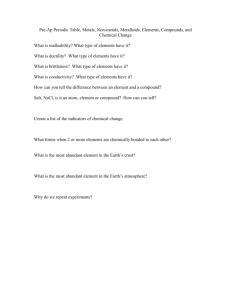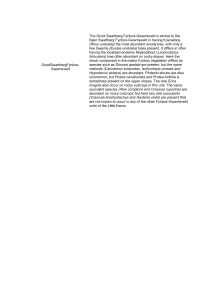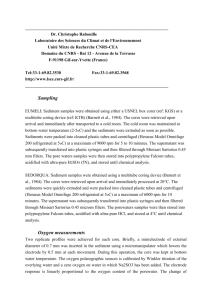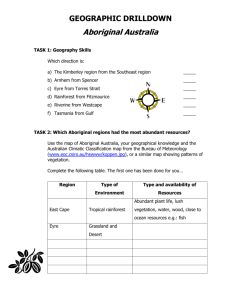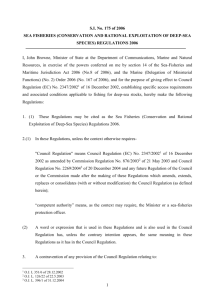Inter-comparison of the active prokaryotic communities in the
advertisement
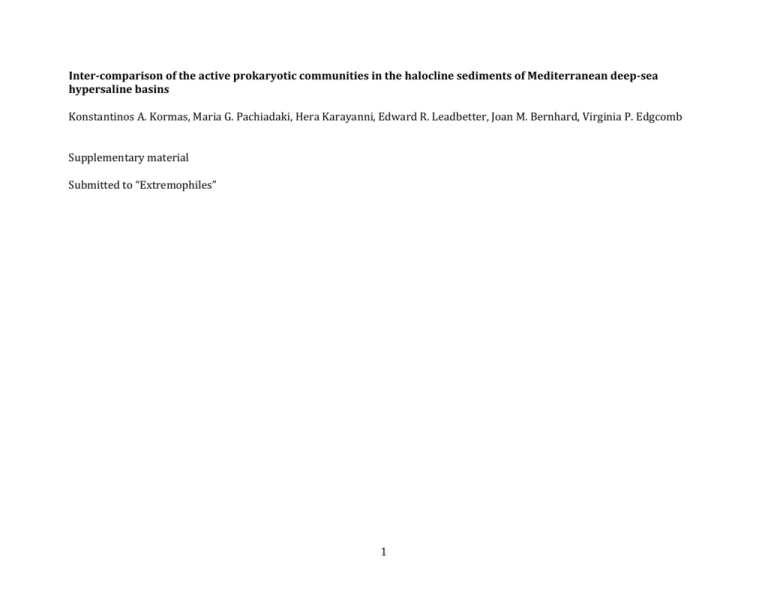
Inter-comparison of the active prokaryotic communities in the halocline sediments of Mediterranean deep-sea hypersaline basins Konstantinos A. Kormas, Maria G. Pachiadaki, Hera Karayanni, Edward R. Leadbetter, Joan M. Bernhard, Virginia P. Edgcomb Supplementary material Submitted to “Extremophiles” 1 Table S1. Physico-chemical data of the brines and haloclines above Urania, Discovery and L’Atalante Basins of the current study and previous studies. Sample L’Atalante Upper Halocline L’Atalante Lower Halocline Urania control Sediment core code (Dive # - Push Core #) 611-6 611-13 608-1 Urania Lower Halocline 609-9 Discovery Upper Halocline 1 609-12 Discovery Upper Halocline 2 Discovery Middle Halocline 610-15 Discovery Lower Halocline 1 610-15 Discovery Lower Halocline 2 610-9 609-17 Coordinates 35°18’N 21°23’E 35°18’N 21°23’E 35°13’N 21°28’E 35°13’N 21°28’E 35°19’N 21°41’E 35°19’N 21°41’E 35°19’N 21°41’E 35°19’N 21°41’E 35°19’N 21°41’E Depth (m) 3499 Total salinity (PSU) 41a Oxygen (µM) 0-50 3501 100a 0 3460 38b 250-260 3470 172b 0 3582 ND/70c 20-100 3583 ND 10-75 3584 102a 0-35 3585 125a 0-2.3 3586 ND 0-0.6 aData from Bernhard et al. (2014). Data based on refractometer readings or standard conductivity sensors, which are not reliable for athalassohaline brines enriched in divalent cations. bRanges provided for oxygen concentrations through the top 2cm used for analyses; from Bernhard et al. (2014). cData from Edgcomb et al. (2011). Discovery upper halocline value for ~1m into halocline. Edgcomb, V.P., W. Orsi, H.-W. Breiner, A. Stock, S. Filker, M.M. Yakimov, and T. Stoeck. 2011, Novel kinetoplastids associated with hypersaline anoxic lakes in the Eastern Mediterranean deep-sea. Deep-Sea Res I 58::1040-1048 2 Table S2. Geochemical characteristics of the surrounding sea water, brines and sediments of Mediterrnaean deep-sea hypersaline anoxic basins from various studies. Urania Control Seawater Urania Control Sediments Urania Brine Urania Lower Halocline Discovery Brine 3470 Urania Lower Halocline Sediments 3470 Discovery Lower Halocline Sediments 3586 L'Atalante Brine 3600 Discovery Upper Halocline Sediments 3583 3550 L'Atalante Lower Halocline Sediments 3501 Depth (m) 3350 3460 3607 Salinity % 3~3.7 3.8 824.0 3~17 17.2 59.5 7 >12.5 2>30% Temperature °C Oxygen (µM) 14.02 14.5 818.3 10 16.9 17.2 114.5 14.05 14.07 814.3 14.1 260 200-250 0 553.6 0 0 10-75 0-0.6 0 0 pH ~8.0 106.8 Na+ 1528 13503 Cl- (mM) 1616 13729 Mg2+ (mM) 160 1316 SO42- 131.8 1107 HS- (mM) 12.6x10-6 116 CH4 (mM) 11.5x10-6 15.56 NO3- (µM) 3~3 11<161 30.5-nd 11322- NH4+(mM) 3nd 82.87 3~2.8 484 73000 (mM) (mM) Mn2+ (µM) Sulfate reduction rate (µM H2S day 1) Methane production rate (µM CH4 day -1) 4~4.5, 168 60 14674 19491 4~9000 15289 579 14995 4~4600 1410 542 196 1397 50.66 10.7 12.9 10.031 10.52 3~3.2 63600 116.4-6.7 96.2 5876 L'Atalante Brine Sediments 62.9 90.8 10.236 129.82 123.91 182.15 10 185.79 12.65 116.93 sediments=porewater nd=not detected 3 6520 1. van der Wielen PWJJ, Bolhuis H, Borin S, Daffonchio D, Corselli C, Giuliano L, D'Auria G, de Lange GJ, Huebner A, Varnavas SP, Thomson J, Tamburini C, Marty D, McGenity TJ, Timmis KN, Party BS (2005) The enigma of prokaryotic life in deep hypersaline anoxic basins. Science 307:121-123 2. Danovaro R, Corinaldesi C, Dell'Anno A, Fabiano M, Corselli C (2005) Viruses, prokaryotes and DNA in the sediments of a deep-hypersaline anoxic basin (DHAB) of the Mediterranean Sea. Environ Microbiol 7:586-592 3. Borin S, Brusetti L, Mapelli F, D'Auria G, Brusa T, Marzorati M, Rizzi A, Yakimov M, Marty D, De Lange GJ, Van der Wielen P, Bolhuis H, McGenity TJ, Polymenakou PN, Malinverno E, Giuliano L, Corselli C, Daffonchio D (2009) Sulfur cycling and methanogenesis primarily drive microbial colonization of the highly sulfidic Urania deep hypersaline basin. Proc Natl Acad Sci 106:9151-9156 4. Wallmann K, Suess E, Westbrook GH, Winckler G, Cita MB (1997) Salty brines on the Mediterranean sea floor. Nature 387: 31-32 5. Filker S, Stock A, Breiner H-W, Edgcomb V, Orsi W, Yakimov MM, Stoeck T (2013) Environmental selection of protistan plankton communities in hypersaline anoxic deep-sea basins, Eastern Mediterranean Sea. MicrobiologyOpen 2:54-63 6. Danovaro R, Dell'Anno A, Pusceddu A, Gambi C, Heiner I, Mobjerg Kristensen R (2010) The first metazoa living in permanently anoxic conditions. BMC Biology 8:30 7. Alexander E, Stock A, Breiner H-W, Behnke A, Bunge J, Yakimov MM & Stoeck T (2009) Microbial eukaryotes in the hypersaline anoxic L'Atalante deep-sea basin. Environ Microbiol 11:360-381 8. La Cono V, Smedile F, Bortoluzzi G, Arcadi E, Maimone G, Messina E, Borghini M, Oliveri E, Mazzola S, L'Haridon S, Toffin L, Genovese L, Ferrer M, Giuliano L, Golyshin PN, Yakimov MM (2011) Unveiling microbial life in new deep-sea hypersaline Lake Thetis. Part I: Prokaryotes and environmental settings. Environ Microbiol 13:2250-2268 9. Antunes A, Ngugi DK & Stingl U (2011) Microbiology of the Red Sea (and other) deep-sea anoxic brine lakes. Environ Microbiol Rep 3:416-433 10. Sass AM, Sass H, Coolen MJL, Cypionka H, Overmann Jr (2001) Microbial communities in the chemocline of a hypersaline deep-sea basin (Urania Basin, Mediterranean Sea). Appl Environ Microbiol 67:5392-5402 11. M. Yakimov pers comm. 4 Table S3. Changes in relative abundance of bacterial and archaeal operational taxonomic units (OTU) along the pelagichalocline sediments in the Urania, L’Atalante and Discovery Mediterranean deep-sea hypersaline basins. Abundant: among the top three most abundant in at least one sample. Increase/Decrease: ≤5%≥ increase/decrease in relative abundance moving towards lower halocline sediments. Notes Closest relative Similarity (%) GenBank accession No. Habitat of origin/Information Reference Bacteria OTU321 Abundant; Increase Variovorax paradoxus BD18-E04 100.0 HF584859 OTU353 Abundant; Decrease 100.0 KF859623 Marasco et al. (2013) Unpublished OTU549 Abundant; Decrease Uncultured Halomonas sp. clone HA_82 Bacillus sp. DV9-31 grapevine root system Deep-sea sediment 100.0 GQ407176 Unpublished OTU554 Abundant; Increase Sphingomonas sp. Lor54 100.0 KJ016215 OTU766 Abundant 98.0 KF338255 OTU1288 99.2 FR872934 L’Atalante Basin OTU1580 Common in Urania control and L’Atalante and Discovery upper haloclines Increase Clone G250WV301A2KT0 – Burkholderia related Clostridium sp. AN-AS8 Badwater salt pan, Death Valley, CA, USA Endolichenic (Lobaria retigera) Shrimp intestine 98.8 NR_041511 cattle farm compost OTU1696 Abundant; Decrease Cellulomonas chitinilytica strain X.bu-b Uncultured Salegentibacter sp. clone HAHS13.027 98.6 HQ397002 Haloalkaline soil OTU1792 Abundant 97.2 KF338845 Shrimp intestine OTU2166 Abundant; Decrease clone G250WV301BL5R6 – Sphingomonas related Alteromonas sp. ECSMB57 100.0 KM369862 nature biofilms formed in the coastal seawater at 5 Unpublished Rungrassamee et al. (2014) Sass et al. (2001) Yoon et al. (2008) Unpublished, but see Dorador et al. (2009) Rungrassamee et al. (2014) Unpublished OTU2570 Abundant Pseudomonas geniculata OTU-a9 100.0 KJ147059 OTU2675 Increase Serratia proteamaculans strain ai2 100.0 KJ194992 OTU2749 Abundant; Decrease Pseudomonas stutzeri strain NM2E7 100.0 KM874453 OTU2940 OTU3104 Abundant; Increase Abundant; Increase 99.3 98.7 KF836499 KM157737 OTU3256 Abundant; Decrease 99.5 GU982762 OTU3339 Abundant; Increase Burkholderia stabilis SPP-21 Uncultured bacterium clone Espejo_9_20_11_Pumice.67702 Uncultured bacterium clone 3051bac1-55 Enterobacter hormaechei D10 100.0 KJ123711 Lactobacillus delbrueckii subsp. bulgaricus Staphylococcus epidermidis voucher RIFA 1117 Uncultured bacterium clone RSB32 Corynebacterium aurimucosum H2456 Firmicutes bacterium M71_D94 100.0 KJ026672 100.0 KF624759 98.8 JF809742 OTU3507 OTU3692 Abundant; Increase OTU3735 Abundant; Decrease OTU4467 OTU4582 Abundant; Decrease 6 Gouqi Island Fungus Pandora neoaphidis endosymbiont “Succession of Lignocelulolytic FacultativeAnaerobic Bacterial Consortia bred from Lake Sediment” Root; Isolation and characterization of endophytic bacteria associated with heavy metals tolerant plants on mine tailings in Villa de la Paz (Mexico) Pumice Pacific deep-sea sediment Vinegar fermentation starter Fermented dairy product ant mound 98.60 Medee DHAB sediment NR_115262 Genomic DNA 98.6 FM992835 Eastern Mediterranean Sea Unpublished Unpublished Unpublished Unpublished Unpublished Unpublished Li et al. (2014) Unpublished Unpublished Akoumianaki et al. (2012) Daneshvar et al. (2004) Gartner et al. (2011) OTU4591 Abundant; Increase Uncultured bacterium gene for 16S rRNA, partial sequence, clone: smkt_B-pro_001_031 Novosphingobium sp. 2P1G10 Uncultured cyanobacterium clone C_13 Psychrobacter nivimaris strain XH236 Uncultured bacterium clone LNH_12_1_11_Water.267033 Pedomicrobium ferrugineum strain ATCC 33119 100.0 AB806525 OTU5570 OTU6564 Abundant Abundant; Increase OTU6924 Abundant; Decrease OTU6939 Abundant OTU7265 Increase OTU7810 100.0 97.3 HF936984 FJ490250 100.0 Abundant; Increase Bradyrhizobium elkanii OTU-c63 100.0 Clone NZ_78_Arch_33 100.0 JN884897 Deep-sea methane seep Clone T13M-A21, Thaumarchaeota MGI 98.2 JN798493 Low temperature Unpublished hydrothermal oxides Clone SB11_H10, Thaumarchaeota 99.5 KF176700 Sponge Tethya aurantia Unpublished OTU004a Most abundant, shared among all three samples Most abundant, shared among all three samples Most abundant, shared among all three samples Most abundant Clone 62.64_c5, Crenarchaeota 98.6 HE579761 OTU005a Most abundant Clone 48H-0S-18 99.5 GU270206 Perner et al. (2011) Dang et al. (2010) OTU006a Most abundant Clone MC118_36A17 99.5 HM601383 Low temperature deep-sea vent Deep-sea methane seep surface sediments Deep-sea hydrocarbon seep Archaea OTU001a OTU002a OTU003a 7 Unpublished KF424830 Shimokita Penninsula offshore drilling core sample River sediment Antarctica Dry Valleys deep-sea sidiments 98.3 KM146672 Pumice Unpublished 100.0 NR_104840 Temperature range Brenner et al. is 10–400C. pH range (2005) is 3.5–10.0. Survival, but no growth, range 1–5% NaCl KJ147076 Fungus Pandora Unpublished nouryi endosymbiont Unpublished Pointing et al. (2009) Unpublished Ruff et al. (2013) Unpublished OTU007a Most abundant Clone Zeebrugge_A84 98.6 HM598534 OTU417a Most abundant clone NapMat-0_4-rtB10b 98.2 HQ443430 sediment Brackish sediments contaminated with hydrocarbons and heavy metals (3 m water depth) Napoli mud volcano hypersaline marine sediment, 0-4 cmbsf Siegert et al. (2011) Lazar et al. (2011) References Akoumianaki I, Nomaki H, Pachiadaki M, Kormas KA, Kitazato H, Tokuyama H (2012) Low bacterial diversity and high labile organic matter concentrations in the sediments of the Medee deep-sea hypersaline anoxic basin. Microbes Environ 27:504508 Brenner DJ, Krieg NR, Staley JT (2005) Bergy’s manual of systematic bacteriology. Second edition. Volume two. The Proteobacteria. Part C. The Alpha-, Beta-, Delta-, and Epsilonproteobacteria. Springer, New York Gartner A, Blümel M, Wiese J, Imhoff J (2011) Isolation and characterisation of bacteria from the Eastern Mediterranean deep sea. Antonie van Leeuwenhoek 100:421-435 Dang, H., Luan, X.W., Chen, R., Zhang, X., Guo, L. and Klotz, M. G. (2010). Diversity, abundance and distribution of amoAencoding archaea in deep-sea methane seep sediments of the Okhotsk Sea. FEMS Microbiol Ecol 72:370-85 Daneshvar,M.I., Hollis,D.G., Weyant,R.S., Jordan,J.G., MacGregor,J.P., Morey,R.E., Whitney,A.M., Brenner,D.J., Steigerwalt,A.G., Helsel,L.O., Raney,P.M., Patel,J.B., Levett,P.N., Brown,J.M. (2004) Identification of some charcoal-black-pigmented CDC fermentative coryneform group 4 isolates as Rothia dentocariosa and some as Corynebacterium aurimucosum: proposal of Rothia dentocariosa emend. Georg and Brown 1967, Corynebacterium aurimucosum emend. Yassin et al. 2002, and Corynebacterium nigricans Shukla et al. 2003 pro synon. Corynebacterium aurimucosum. J Clin Microbiol 42:4189-4198 Edgcomb, V.P., W. Orsi, H.-W. Breiner, A. Stock, S. Filker, M.M. Yakimov, and T. Stoeck. 2011, Novel kinetoplastids associated with hypersaline anoxic lakes in the Eastern Mediterranean deep-sea. Deep-Sea Res I 58::1040-1048 Li, P., Li, S., Cheng, L. and Luo, L. (2014) Unraveling the relation between the microbial diversity of DaQu and the turbidity spoilage of traditional Chinese vinegar. Appl. Microbiol. Biotechnol. 98:6073-6084 Marasco, R., Rolli, E., Fusi, M., Cherif, A., Abou-Hadid, A., El-Bahairy, U., Borin, S., Sorlini, C. and Daffonchio, D. (2013) Plant growth promotion potential is equally represented in diverse grapevine root-associated bacterial communities from different biopedoclimatic environments. Biomed Res Int, Article ID 491091 8 Perner, M., Hentscher, M., Rychlik, N., Seifert, R., Strauss, H. and Bach,W. (2011). Driving forces behind the biotope structures in two low-temperature hydrothermal venting sites on the southern Mid-Atlantic Ridge. Environ Microbiol Rep 3:727-737. Pointing SB, Chan Y, Lacap DC, Lau MCY, Jurgens JA, Farrell RL (2009) Highly specialized microbial diversity in hyper-arid polar desert. Proc Natl Acad Sci USA 106:19964-19969 Sass AM, Sass H, Coolen MJL, Cypionka H, Overmann Jr (2001) Microbial communities in the chemocline of a hypersaline deepsea basin (Urania Basin, Mediterranean Sea). Appl Environ Microbiol 67:5392-5402 Siegert, M., Cichocka, D., Herrmann, S., Grundger,F., Feisthauer, S., Richnow, H.H., Springael, D. and Kruger, M. (2011) Accelerated methanogenesis from aliphatic and aromatic hydrocarbons under iron- and sulfate-reducing conditions. FEMS Microbiol. Lett. 315:6-16. Yoon M-H, Ten LN, Im W-T, Lee S-T (2008) Cellulomonas chitinilytica sp. nov., a chitinolytic bacterium isolated from cattle-farm compost. Int J Syst Evolut Microbiol 58:1878-1884 9 Figure S1. Bathymetry of the L’ Atalante halocline zone (white zone). N = normoxic control region, UH=upper halocline, MH=middle halocline, LH=lower halocline, B=brine. Image © Woods Hole Oceanographic Institution, USA. 10

